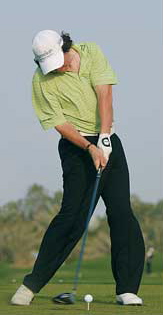People these days are catching up to Moe Norman, the straight-hitting Canadian savant who might have been the best ball-striker to ever live. There’s even a movie coming out about his life. There’s a golfing school based on his swing, called Natural Golf. Moe Norman — the best golfer you’ve never heard of. Except he isn’t.
Count Yogi is.
Real name, Harry Hilary Frankenberg, born in 1906. The story goes that he was standing in a corn field, long before Shoeless Joe, and heard a voice say to him, “your brain is your body’s greatest gift – use it. Watch the ball with your eyes, but put your brain eyes (like a blind person would) on the end of your stick (club head). Take the stick back and return it, circling under to loosen, standing tall and straight with perfect relaxed posture.”
Whatever that means, it meant something to him and he became a marvelous golfer whose list of accomplishments you can read on many web sites.
His five-word mantra about golf was, “Simple game. Nothing to it.” It was all about controlling the clubhead, and “you should always be loose, boneless, muscleless, effortless, because when you are, you can mentally control the clubhead.”
The backswing: pull it back “to control,” one of his students said. Farther than that and you’ll lose control.
”I have always been a consistently straight golf-ball hitter because I have eliminated virtually every idea suggested in numerous instruction articles in books, magazines and newspapers. I keep the swing simple and think only of being relaxed, graceful and smooth.”
“I play with an infallible mental routine and have ever since I was a little boy. I don’t play with my hands, my wrists, my arms, my age or my strength. I play with 100% brain.”
He had a five-step setup that was a key element of his swing, which helped him take the body out of the swing, his thinking brain out of the swing, and just use his natural motion controlled by his subconscious mind.
Listen and watch him go through the steps in this video.
Yes, he’s off balance at the end of his swing, but don’t let that bother you. There are other videos of him swinging that I recommend you look for, because they show a swing of great beauty and effect. The key point for me is that he wants you to let your natural instincts take over. When you’re standing over the ball, reviewing your swing thoughts, worried about the result of the shot, whether you can pull it off, and all the other self-talk you conjure up, none of that has anything to do with what you’re about to do—hit the golf ball.
If you can find a way at all to quiet that part of your brain, and just swing, you’ll play better golf and have more fun. You can learn a lot from Count Yogi, the man who made that his life’s message.
My new book, The Golfing Self, is now available at www.therecreationalgolfer.com. It will change everything about the way you play.


